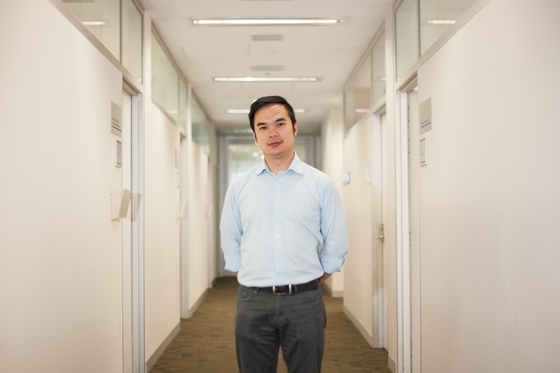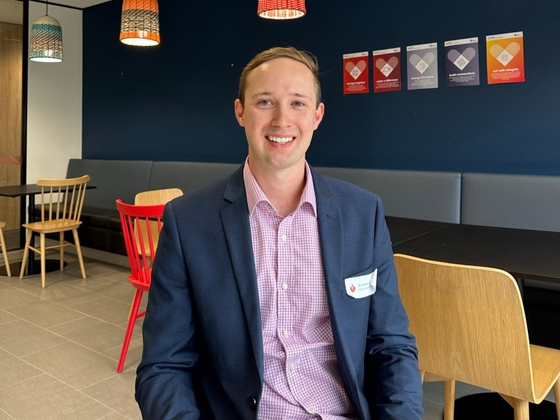1500px.jpg?format=pjpg&auto=webp)
Q&A with Dr Jarmon Lees
Translating new therapies for Friedreich ataxia heart disease
Dr Jarmon Lees is a medical researcher working on heart disease at St Vincent’s Institute in Melbourne. He studied marine biology at the University of Melbourne before moving into stem cell research.
Stem cells had been around for a while, but we had only just learned how to make stem cells from adult cells at that time, and the possibilities seemed endless. Stem cells are fascinating to work with. They can turn into almost any cell, which makes them invaluable for studying things like the human heart or brain”.
Dr Jarmon Lees
Research Fellow
Dr Lees’ PhD explored what ‘food’ stem cells require to grow, and he now uses them to create miniature models of human heart tissue in the lab to better understand heart disease. Outside his research, he enjoys family life and playing the trombone.
What are you currently researching?
My research aims to develop new treatments for heart disease caused by Friedreich ataxia – a rare and life-threatening genetic condition known for affecting movement and coordination (ataxia). Most people with Friedreich ataxia sadly don’t live past 38. In my research, I use stem cells from people with Friedreich ataxia to create tiny heart tissues in the lab. This allows me to investigate how the disease affects the heart and test new treatments.
My approaches include screening thousands of existing medicines to see if any could be safely and quickly reused to treat this condition. We are also exploring new RNA therapies that might reverse heart damage in ataxia. By combining these approaches with both lab and animal studies, we hope to turn promising discoveries into treatments that can improve the lives of those affected by Friedreich ataxia.
What difference will your research make to people’s cardiovascular health in Australia?
My research will make a real difference in cardiovascular health in Australia by providing new treatment options for Friedreich ataxia heart disease, a condition with no current cure. By focussing on medicines that are already approved, and new RNA-based therapies, we are working to speed up the development of new treatment options. This will not only improve the quality of life and life expectancy for people with Friedreich ataxia but also reduce the healthcare burden associated with managing this complex disease. My innovative approach using human heart models can be applied to other inherited heart diseases, potentially benefiting a broader range of cardiovascular conditions and improving cardiovascular health in general in Australia.
What motivated you to do your research?
My motivation for pursuing this research stems from a deep commitment to improving the lives of those affected by Friedreich ataxia. Witnessing the devastating impact of Friedreich ataxia on people with this disease and their families, drives my passion for finding effective treatments. The current lack of treatments and the urgent need for innovative solutions has inspired me to use my expertise in stem cell and cardiovascular research to make a meaningful difference. My goal is to translate laboratory findings into real-world solutions that can offer hope and a better life for those living with Friedreich ataxia.
Are there any achievements or discoveries from the past year you can share with us?
In the past year, my team has made significant strides in developing new treatments for Friedreich ataxia heart disease. We successfully identified two promising gene targets, which are overexpressed in Friedreich ataxia and may play a role in the disease's progression. Our preliminary studies have shown that reducing the expression of these genes in heart tissue can reverse some of the cardiac damage associated with Friedreich ataxia. Additionally, we have advanced our drug screening efforts, identifying several clinically approved compounds that show potential in treating Friedreich ataxia heart disease. These are exciting steps forward, and we’re continuing to follow up on these discoveries now.
What role has Heart Foundation funding had in your career journey?
The Heart Foundation Future Leader Fellowship is crucial for my research and career. It allowed me to expand my team, run large-scale drug testing, and explore new RNA therapy approaches for Friedreich ataxia heart disease.
This support has helped move our work closer to clinical application, where it can start making a real difference in people’s lives. Funding from the Heart Foundation has allowed me to explore new ideas, build new collaborations, and expand my research team. I’m grateful that the Heart Foundation is willing to invest in my research and support the fight against rare diseases like Friedreich ataxia.
Do you have a message for Heart Foundation supporters?
Thank you. I am deeply grateful for the generous support from Heart Foundation donors. Because of your contribution, my team is able to research new treatments that could change the lives of people living with Friedreich ataxia heart disease, a fatal condition with no current cure.
You’re helping us give hope to families facing this devastating condition. Your belief in medical research means the world to us – and to the people who stand to benefit from it. Thank you for being part of this journey.
You might also be interested in...

Q&A with Associate Professor Quan Huynh
Associate Professor Quan Huynh focuses on enhancing care for heart failure patients with cognitive and physical frailty through innovative research.

Q&A with Professor Seana Gall
Professor Seana Gall, cardiovascular epidemiologist at the University of Tasmania, focuses on preventing heart disease and stroke through innovative research.

Q&A with Dr Lachlan Dalli
Dr Lachlan Dalli researches real-world effectiveness of medicines and vaccines to prevent stroke and improve cardiovascular health outcomes.
Last updated19 June 2025
